#dana hanrahan
Explore tagged Tumblr posts
Text
In Batman 444, cover date February 1990, Dana Hanrahan was introduced and marked the final appearances of Crimesmith and Jeffrey Fraser (dies). Dana Hanrahan was created by Marv Wolfman and Jim Aparo. ("Crimesmith and Punishment" Batman 444, DC Comic Event)

#nerds yearbook#real life event#first appearance#final appearance#dc#dc comics#february#1990#marv wolfman#jim aparo#batman#bruce wayne#tim drake#crimesmith#jeffrey fraser#dana hanrahan#james gordon#lucius fox#gotham city#wayne manor#batcave#waynetech
55 notes
·
View notes
Text

Batman #450: Wildcard!
Released: July 1990 Written By: Marv Wolfman Pencils: Jim Aparo Inks: Mike DeCarlo Cover By: Norm Breyfogle Synopsis (via dcuguide.com): A series of gag-based murders takes place in Gotham, and the chief suspect - the Joker - is soon spotted at the scene of one of the crimes. However, both Batman and Commissioner Gordon begin to suspect this could be the work of a copycat. Elsewhere, the Joker fumes at the misuse of his name and image, while the true culprit, businessman Curtis Base, begins to exhibit signs of insanity.









Part Two
#batman 450#batman comics#tim drake#bruce wayne#alfred pennyworth#james gordon#dana hanrahan#vicki vale#curtis base#the joker
7 notes
·
View notes
Text
The Case of the Chemical Syndicate

DETECTIVE COMICS #627 MARCH 1991 BY BILL FINGER, BOB KANE, MIKE FRIEDRICH, MARV WOLFMAN, ALAN GRANT, BOB BROWN, JIM APARO, NORM BREYFOGLE, JOE GIELLA, MIKE DECARLO, STEVE MITCHELL AND ADRIENNE ROY
SYNOPSIS (FROM DC FANDOM)
This story is reprinted from Detective Comics #27.
Commissioner Gordon relaxes at home entertaining his young socialite friend Bruce Wayne. Wayne asks if anything exciting has happened lately, and Gordon explains that a fellow called the "Bat-Man" is puzzling him. Gordon receives a call that chemical manufacturer Lambert has been found murdered. They have Lambert's son in custody, whose fingerprints were found on the knife. Gordon invites Bruce Wayne to the Lambert mansion with him, and Bruce Wayne says he has nothing better to do.

When they arrive at the crime scene, young Lambert insists he is innocent. The lad explains that he arrived home early and saw his father lying on the floor. When he entered the library, he saw a figure escaping out the window. He pulled a knife out of his father's back, and his father's last word was "contract." Lambert's son recalls that his father had three associates, Alfred Stryker, Paul Rogers, and Steve Crane. Steve Crane calls Gordon on the phone. Lambert told Crane that he had received a death threat the previous day. Crane has received a similar death threat, and asks for police protection. Bruce Wayne decides to go home, and Gordon rushes over to the Crane residence.
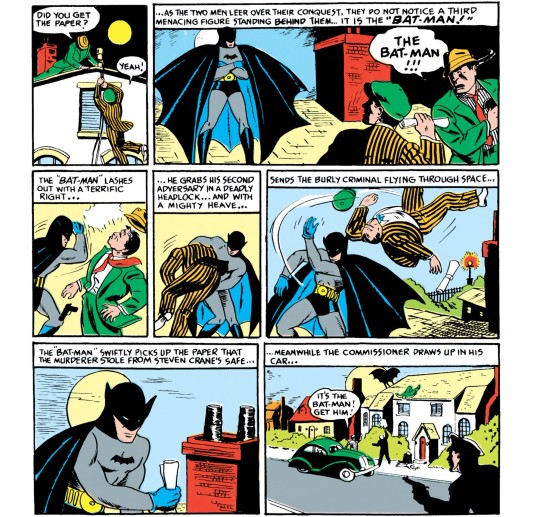
Steven Crane is killed by a gunman who enters through the window. The thug and his partner steal a paper from Crane and climb onto the roof. They are confronted by a figure they recognize as the Bat-Man, standing in the moonlight. The Bat-Man punches the first thug out, then grabs the second one in a headlock and throws him off the second-story roof. He grabs the paper and escapes as Gordon is pulling up. The GCPD try to arrest the Bat-Man, but they are unable to catch him. Gordon learns that Crane has been murdered, and moves on to the next business partner. The Bat-Man smiles when he reads the paper he stole, and drives off in his automobile.
Paul Rogers visits the laboratory of Alfred Stryker, having learned of Lambert's death by news broadcast. Stryker's assistant Jennings clubs Rogers over the head and ties him up. Jennings explains that he will lower a gas chamber over Rogers and kill him the same way he puts animals to sleep. Jennings leaves to activate the gas. The Bat-Man leaps into the room through an open transom. The Bat-Man grabs a wrench and dives inside the gas chamber before it closes.
He plugs the gas jet with a handkerchief, and busts through the glass with his wrench. Jennings returns and tries to pull a gun on the Bat-Man, but the Bat-Man punches him in the face really hard. Alfred Stryker enters and demands to know what happened. When Rogers explains that Jennings tried to kill him, Stryker pulls out a knife to finish the job. The Bat-Man is hiding in the shadows, and he grabs Stryker from behind to stop him. The Bat-Man explains to Rogers that they were all partners in the Apex Chemical Corporation. Stryker had made secret contracts with all of them to pay them a sum of money each year until he owned the business. He grew tired of waiting and decided to kill them so he wouldn't have to pay. Stryker breaks out of the Bat-Man's grip and pulls a gun on him. The Bat-Man punches Stryker so hard in the face that Stryker breaks through a railing and falls into a tank of acid. The Bat-Man remarks that this is a fitting end for his kind, and leaves via transom. Rogers tries to thank the Bat-Man, but he is already gone.

Later at his house, Commissioner Gordon relates this story to Bruce Wayne. Bruce remarks that this is a lovely fairy tale, and leaves. Gordon thinks to himself that Bruce Wayne is a nice young chap, but he seems to lead a very boring life. Bruce returns home to Wayne Manor, where it's revealed that he is in fact the Bat-Man.
This story is reprinted from Detective Comics #387.
Batman and Robin swing across Gotham City. They arrive at a crime scene where the wealthy atomic chemist Lambert has been murdered with a poker in his own living room. Commissioner Gordon is accusing Lambert's hippy son Mel, whose fingerprints were found on the murder instrument. Mel is furious and rants about authority figures abusing their power. Batman determines that the fingerprints could have gotten there at any time, and they cannot prove that Mel is guilty. Batman and Robin leave to investigate while Gordon has his back turned. Mel announces that the scene is one big bummer and he is going to split.

Batman and Robin return to the Batcave, where they're welcomed by Alfred Pennyworth. Robin hates Mel, believing that punks like him should all be locked up without a key. Batman reminds him that their job is to protect everyone's rights, not just those of the people they like. The Batcomputer determines that Lambert was part of a chemical syndicate with three other men, Alfred Stryker, Paul Rogers, and Steven Crane.
They drive to visit Steven Crane in the Batmobile. Crane explains that Mel and his father had a heated argument several days ago in the lab. The elder Lambert insisted that his chemical research would benefit all mankind. Mel Lambert insisted that the research would really be used for military purposes, and lead only to advances in war. Robin believes this proves Mel guilty, but Batman tells him not to jump to conclusions. They leave the apartment and hear gunshots behind them, as Crane is murdered. They rush back in and the killer shoots at them as well. His silhouette resembles Mel Lambert, and he escapes but drops a piece of paper when Robin hits him with a batarang. The paper is an account of Crane's part in the research. Batman believes this casts doubt on Mel as a suspect, but Robin believes it confirms his suspicions. They rush to find Paul Rogers next.
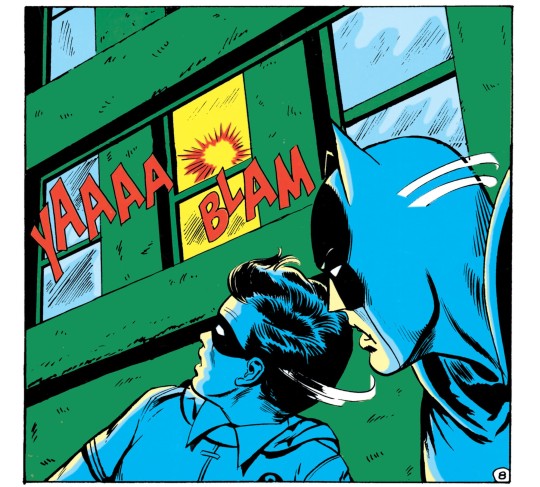
Paul Rogers has heard about Lambert's murder, and gone to visit the laboratory of Alfred Stryker. Stryker lets Rogers inside, and Rogers is clubbed on the back of the head with a gun. The culprit is a masked man resembling Mel Lambert. Batman and Robin burst in, and they take down the masked man. It is not Mel Lambert, only a man dressed like him. Stryker picks up the gun and reveals that he hired this killer to do his dirty work. Stryker forgets to keep track of Batman in the shadows, and Batman karate chops the gun out of his hand. Batman explains that he knew one of them was the culprit because only someone involved in the chemical syndicate would want Crane's research data. Stryker was attempting to eliminate his partners so he could claim their research as his own for financial gain. Mel Lambert was simply a convenient scapegoat to frame for the murders.
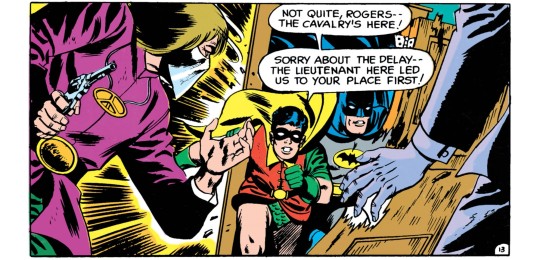
That night, Mel Lambert and Robin are both troubled. Mel Lambert criticized Batman for being part of the system, but Batman was the only reason he wasn't thrown in jail. Robin realizes that he tried to jail an innocent man simply because he didn't like him personally. They both know they have some thinking to do.

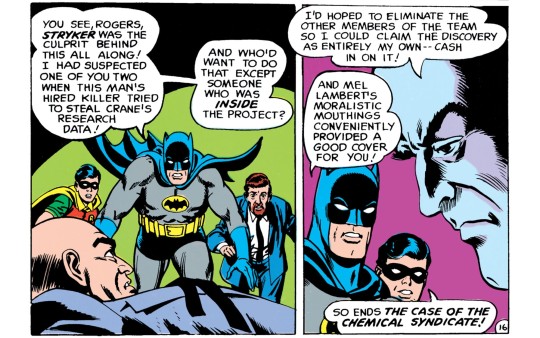
Batman watches over the city at night. An older man gets into a cab with an Iranian driver, who complains about racism in America. The cab is attacked by a costumed woman who sprays it with acid, destroying the vehicle and killing its passenger. The woman announces that her victim coordinated transportation, so it is only fitting he died in transport. The Iranian later recounts these details to homicide detective Dana Hanrahan. Batman arrives and Dana tells him that the victim was Theodore Lambert, Vice President of CLRS Chemicals.

Bruce Wayne knows Theodore's son Ted Lambert, and has Alfred set up a late-night tennis game with him. Ted complains to Bruce about his father, who made his fortune by abusing the environment. Ted announces that he is waiting for his father to die, so he can undo this damage using his father's fortune. Hanrahan arrives and accuses Ted Lambert of murdering his father. Ted admits to a history of arguing with his father about chemical dumping, but insists that he loved his father.

There is a press conference held for CLRS Chemicals by public relations executive Steven Crane. Crane tries to put a positive spin on their dumping, insisting that these chemicals can be used to save the planet. They are developing cleaning materials and pesticides to kill viruses and bacteria. The costumed woman arrives and reveals that she calls herself Pesticyde. Pesticyde murders Steven Crane and his wife in front of a giant crowd, melting them both into a pile of goo. The crowd scream and run in terror, so she begins killing them indiscriminately. Batman arrives to investigate the convention center, and Pesticyde tries to kill him. Pesticyde escapes by burning a hole into the sewers. Hanrahan is horrified when she arrives, and throws up several times at the sight of the melting bodies.

Hanrahan investigates Fred Stryker, the chemist at CLRS Chemicals. Stryker was disfigured in a horrible chemical accident, and is now confined to a wheelchair. His nursemaid Mrs. Watkins tells the police that he cannot move or speak, so Hanrahan leaves. It's revealed that Fred Stryker has a daughter named Priscilla Stryker, who took the identity Pesticyde to avenge him. The other three executives at CLRS refused to listen when Fred told him their chemicals were too dangerous and harmful. They were only concerned with making a profit. When a machine broke, the chemicals fell onto Fred Stryker. This was apparently a mechanical error, but Priscilla believes it was a plot by the others to kill him.
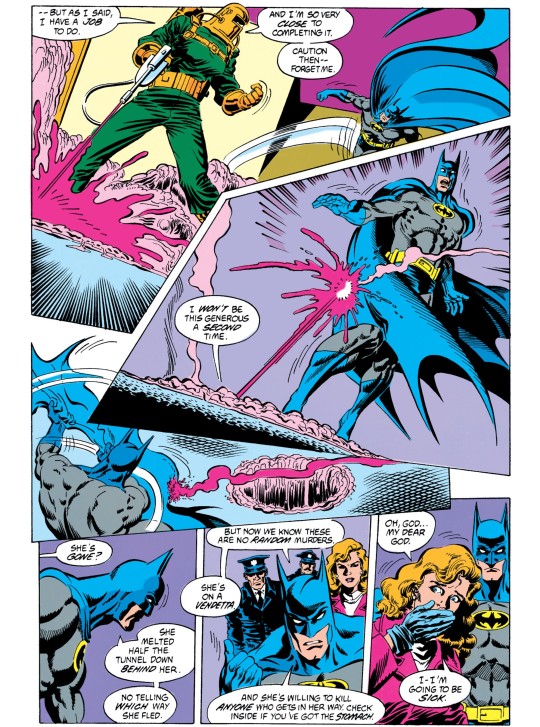
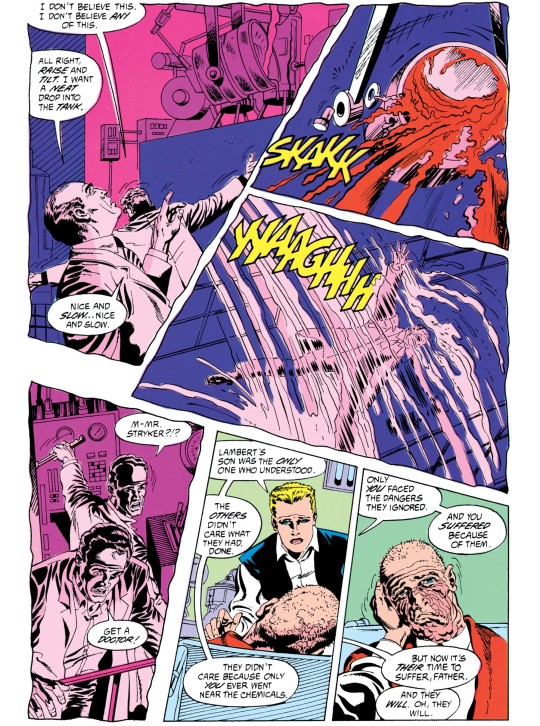
The only remaining executive is Paul Rogers, in charge of business at CLRS. He denies police protection, but Pesticyde easily breaks through his security system. Pesticyde reveals her identity to Rogers, who is her godfather. She kidnaps him to a chemical processing plant, where she dangles him over the vat of chemicals that destroyed her father. Batman arrives just in time and knocks the remote out of her hands with a batarang. He is barely able to swing Rogers to safety before she returns fire. Batman and Pesticyde battle on the catwalk. Pesticyde insists that she is not a killer, she only wants justice, and asks if Batman wouldn't do the same. Pesticyde accidentally destroys the ground underneath her, and falls to her death in the tank of chemicals she prepared. Batman stands on the catwalk and says that he would not do the same thing.
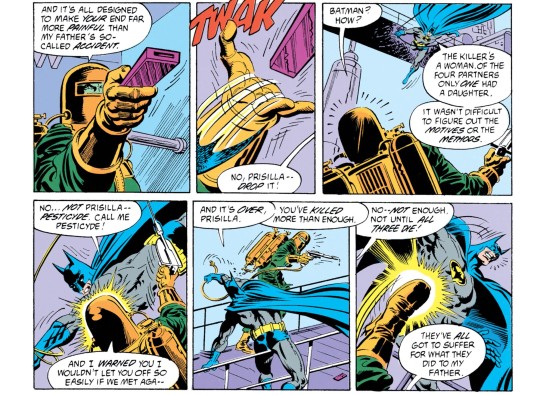
Late at night, a bum walks down the highway into Gotham City. He finishes drinking his bottle of table wine and throws it at a sign. There is a disturbance at G.C. Chem Co. when a thief steals something in one of the trucks. Batman and Commissioner Gordon arrive to investigate. The guard on duty explains that he chased the thief to an office, where they stumbled on the corpse of company owner Professor Lambert. The thief takes his mask off and reveals that he is Mel Lambert, Professor Lambert's son. Batman determines that Mel could not have been the killer, based on fibers on the knife. Batman realizes that Mel is still hiding something, and grabs a bag of cocaine out of Mel's pocket. Mel pulls a gun and threatens to shoot Commissioner Gordon. Batman throws the cocaine in Mel's face and punches him out. Mel is taken into custody.
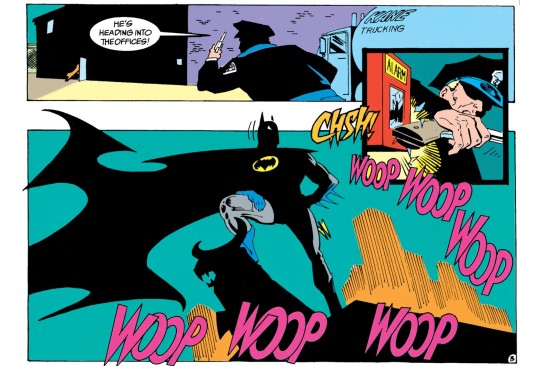
Batman leaves to check up on Professor Lambert's partners. The homeless man from the beginning tries to tell a cop that his friends are dead, but the cop won't listen to a drunk. Lambert's partner Steven Crane is at home reading when his butler receives a call from Gordon. His butler opens the door and is pistol-whipped by two robbers. The robbers force Crane to open his safe, then shoot him in the head. Batman bursts in and violently beats the two killers. They confess that a man named Paul Rogers hired them to make it look like a robbery. Batman and Gordon rush to the Rogers Chemicals building.

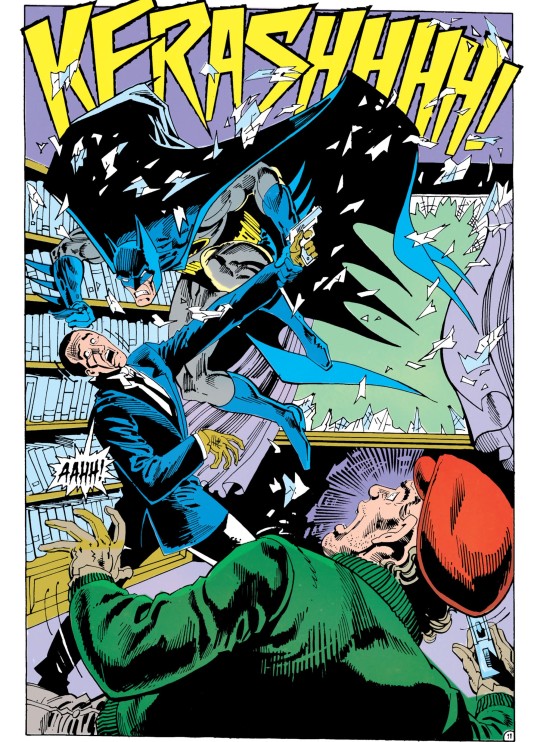
The homeless man is attacked by several muggers, but Batman sees this and defends him. Paul Rogers is innocent, and the real culprit is his partner Alfred Stryker. Stryker forces Rogers to write a suicide note at gunpoint, claiming responsibility for ordering the deaths of his friends. Gordon arrives at Rogers Chemicals to find Paul Rogers swinging dead on a noose. Batman arrives and does not believe the suicide note. He knows Alfred Stryker is still in the building, and calls out to him. Stryker fires his gun at Batman and Gordon. Batman throws a batarang to make Stryker drop the gun. Stryker tries to leap over a metal railing, but the railing collapses and he falls to his death in a tank of acid. Batman fishes out Stryker's skeleton, and remarks that this is "a fitting end for his kind."
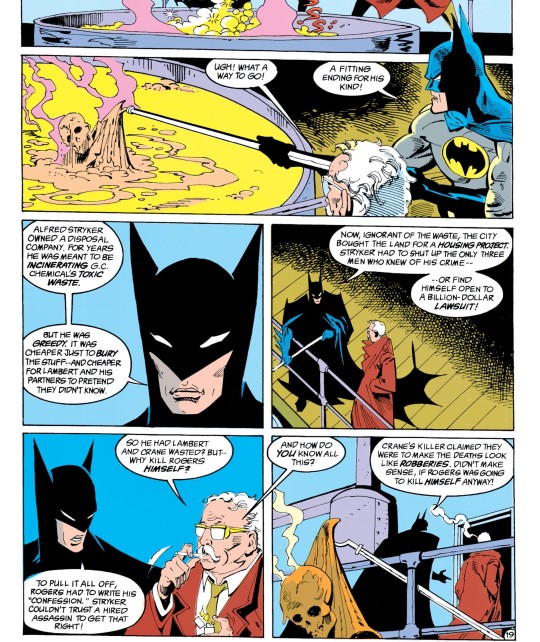
Batman explains that Alfred Stryker owned a waste disposal company partnered with Lambert, Crane, and Rogers. To increase profits, Stryker illegally buried the toxic waste and his partners kept quiet. The city bought Stryker's dumping grounds for a housing project, and this lead to an incident where several homeless men died. Stryker killed off his partners so they couldn't report him to the police.
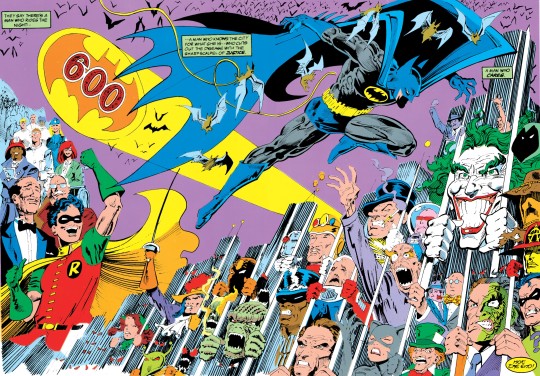
REVIEW
So, two reprints (one of them already reviewed) and two new versions (by the then creative teams of Batman and Detective Comics).
The second story is odd, Robin is profiling hippies, while at the same time he is hanging around with heaps of them when he is with the Titans. Being so conservative doesn’t really fit the character. Another problem I have with this version of the story is that the main theme here is atomic power, so while it is related, I doubt a “chemical syndicate” would be involved. This, by the way, would be Earth-1 version of the case.
Wolfman and Aparo’s version is pretty much horror. This was common in the modern age (and in Batman). While this story is perhaps the strongest one in the book, I felt it was a bit anti-climatic. I was also confused by the detective first, as she looked exactly like Sarah Essen (who was around back then). That’s one of the problems with Aparo’s art, everyone has pretty much the same face and expressions (sometimes there are certain combinations where he does look a bit different).
The Grant and Breyfogle story is plagued with references to several Batman artists. Since I am biased for Breyfogle, this is the one I enjoyed the most. But I admit it starts to force itself to become a homage by the end. Which is ok by me, as the whole purpose of this issue is to do an homage.
While the first two stories happened in Earth-2 and Earth-1 respectively, the last two are probably imaginary stories (as both of them happen in modern times). But of those two, the Wolfman version is more in continuity than the one from Grant (as Gordon just had a heart attack).
I give this issue a score of 8
#norm breyfogle#detective comics#batman80#batman#comics#review#dc comics#1991#modern age#silver age#golden age
4 notes
·
View notes
Text
Uber, DoorDash feeling the heat in blue state gig-worker push
New Post has been published on https://thebiafrastar.com/uber-doordash-feeling-the-heat-in-blue-state-gig-worker-push/
Uber, DoorDash feeling the heat in blue state gig-worker push
The discussions in New Jersey and New York come on the heels of a lengthy debate in California that has the potential to redefine whether gig workers for companies like Uber and DoorDash should be treated as company employees. The fights in Sacramento and Trenton — and likely in Albany next year — could be an early indicator of what’s to come in other statehouses across the country.
It’s all part of a broader push by organized labor to embolden workers with more rights like overtime pay and the ability to unionize. But many in the business community fear this could jeopardize the status of legitimate independent contractors.
In California, a 2018 state Supreme Court ruling set out a stricter classification test that generally means app-based workers should be treated as employees, not independent contractors. The state Legislature followed up with a law to codify the ruling while exempting numerous professions — but not on-demand workers. Uber, Lyft, DoorDash, Instacart and Postmates are trying to lure lawmakers back to the negotiating table by committing $110 million toward a ballot initiative that would define their workers as contractors.
In California, freelance journalists are suing to block the law, and Vox Media said on Monday that it would cut hundreds of SB Nation freelancers as the law’s January implementation approaches. Assemblywoman Lorena Gonzalez (D-San Diego), the author of the law, said Vox’s decision showed the company had been misclassifying workers, but that also she is working on a change to allay concerns from freelancers.
Opponents have drawn parallels between the measure making its way through the New Jersey Legislature and the California law. But state Senate President Steve Sweeney, the lead sponsor of the New Jersey bill, says his legislation is unlike what’s taking place on the West Coast.
Sweeney, a Democrat and officer with the Ironworkers International of North America, acknowledged his original bill would have restricted who qualifies as an independent contractor. He has since scaled back his proposal and says his intent is only to codify existing regulations.
“If you’re truly an independent contractor then this is not going to affect you,” Sweeney said. “But there’s many businesses — construction, trucking, you name it — where they classify their workers as independent contractors and they’re not. They’re depriving their workers of protections and cheating the state out of revenue.”
A similar effort is underway in New York state, where a group of labor advocates has formed a coalition to impose a new standard for what qualifies as an “independent contractor.” It’s expected to be a major part of the legislative agenda in Albany next year.
The issue is also seeping into the presidential race. Sen. Elizabeth Warren was the first to endorse the California bill and other Democratic presidential candidates quickly followed.
“I believe in markets and in providing entrepreneurs the chance to succeed,” Warren wrote in an op-ed for the Sacramento Bee . “But markets without rules and workplaces without labor protections are ripe for exploitation.”
Every 2020 candidate serving in Congress has co-sponsored the “Protecting the Right to Organize Act,” H.R. 2474 (116), which would amend federal labor law to California‘s stricter independent contractor test. Former Vice President Joe Biden and South Bend, Ind., Mayor Pete Buttigieg also say they support the legislation.
The bill would dramatically expand labor rights for gig workers, give them the ability to form unions and protect their right to discuss their work conditions. It advanced out of committee in September, but the measure has not yet been scheduled for a floor vote.
Under the Trump administration, federal regulators have made it easier for companies to say their workers are independent contractors who aren’t protected under federal laws that only apply to “employees.”
The Labor Department issued an opinion letter in April clarifying that workers who are connected to jobs via app-based platforms don’t meet the legal definition of an employee under federal minimum wage and overtime law, citing a six-part legal test. And in January, the National Labor Relations Board, which adjudicates labor disputes,reversed an Obama-era decision that made it harder for employers to classify workers as independent contractors under federal labor law.
With some states taking action, company CEOs are working to get ahead of the issue.
Oisin Hanrahan, the CEO of Handy, a platform for cleaning and other home services, recently put forth suggestions for alternative ways to write legislation. Hanrahan suggested a set of policy guidelines, including reclassifying gig economy contractors as employees if they work 25 hours per week for a single platform.
“Handy has been pushing for innovative ways of guaranteeing workers comprehensive benefits for years,” Hanrahan said in a statement. “But now is the time we can actually make it happen as part of a comprehensive reform to the industry.”
Meanwhile, the delivery app DoorDash supports a bill that gives workers flexibility and benefits, such as requiring medical and disability coverage for on-the-job injuries. But company spokesperson Liz Jarvis-Shean said the New Jersey bill does not achieve that.
“An approach that pairs worker flexibility with economic security will also help ensure that our platform can continue to fuel local economies throughout New Jersey by empowering small businesses to reach new customers,” she said in a statement. “The legislation in its current form will not achieve these important objectives.”
In New Jersey, the backlash to Sweeney’s original reclassification bill was swift and fierce. Lawmakers and staffers say they were inundated with pushback from industry groups and freelance journalists, whom they insist will not be impacted by the current version of the bill.
But even with the changes Sweeney made to the legislation, which union proponents say will help insulate New Jersey from litigation, there’s still a widespread fear it could threaten the status of legitimate independent contractors in the state.
“The way that [the contractor test] is being applied is precisely what is broken,” said Lisa Yakomin, the president of the Association of Bi-State Motor Carriers, which represents truckers. “It’s outdated, oversimplified, vague and is being interpreted in a dangerously subjective way by the New Jersey department of labor.”
It’s unclear if the bill will get to the governor’s desk by the end of the legislation session next month. But regardless, top lawmakers say they will get it done and are still taking amendments under consideration.
At the same time, New Jersey’s Department of Labor and Workforce Development has made misclassification a top issue, and has gone after bad actors. The department last month ordered Uber to pay $650 million in unemployment and disability insurance taxes for misclassifying drivers.
It’s a decision Uber says it will fight.
Proponents argue misclassification of workers is not isolated to app-based companies. Eric Richard, the legislative affairs director for the New Jersey AFL-CIO, said many businesses are exploiting workers, and misclassification has been a rampant practice in the trucking and construction fields for decades.
“Employers often seek this classification to reduce their payroll costs, minimum wage and pension plans,” he said. “This is not a small issue, this is a widespread problem throughout the state that needs to be addressed.”
Meanwhile, drivers for both Uber and Lyft have filed class action lawsuits in New Jersey, claiming the companies owe them back pay for misclassifying them as independent contractors.
But at least one driver for Lyft is fighting the legislation in New Jersey, saying he doesn’t want to lose the ability to work when he wants.
“If I had to give up my independent contractor status, and be forced into a traditional job where I couldn’t decide where and when I work, I could potentially lose the lifeline that helped me turn my life around,” Kevin Foushee wrote in an op-ed for NJ.com. “As lawmakers debate the future of my work, I urge them to preserve the flexibility and independence that I and many like me have come to depend on.”
Dana Rubinstein and Rebecca Rainey contributed to this report.
Read More
0 notes
Text

Batman #444: Crimesmith And Punishment
Released: Feb, 1990 Written By: Marv Wolfman Pencils: Jim Aparo Inks: Mike DeCarlo Cover By: Michael Bair Synopsis (via dcuguide.com): Batman begins to track down the Crimesmith as he also begins to train Tim Drake in crimefighting techniques. They discover evidence that suggests Jeffrey Fraser, a scientist called in to help WayneTech's public image, is the Crimesmith. Batman pursues Fraser to his dangerously booby-trapped house and confronts him, only to see him slain by the real Crimesmith - Fraser's "assistant", who gets away.









Part Two
1 note
·
View note
Text
The Electrocutioner (II) was introduced in Detective Comics 626# (cover date February, 1991) and he was created by Marv Wolfman and Jim Aparo. ("Return of the Electrocutioner", Detective Comics 626#, Comic, Event)

#nerds yearbook#real life event#first appearance#comic book#dc#dc comics#february#1991#the electrocutioner#the electrocutioner 2#marv wolfman#jim aparo#detective comics#batman#commissioner james gordon#sarah essen#dana hanrahan#alfred pennyworth#charlie fisher#vinnie sparrow
6 notes
·
View notes